Second wave: How the rest of Europe is dealing with an alarming rise in cases

Governments across the continent are bringing in new, tougher measures to try to contain the second wave of infections.
More than 700,000 new cases were reported in Europe last week, an increase of 34 per cent compared to the week before, the World Health Organisation said on Tuesday.
Deaths were up 16 per cent in the region last week compared to the previous week.
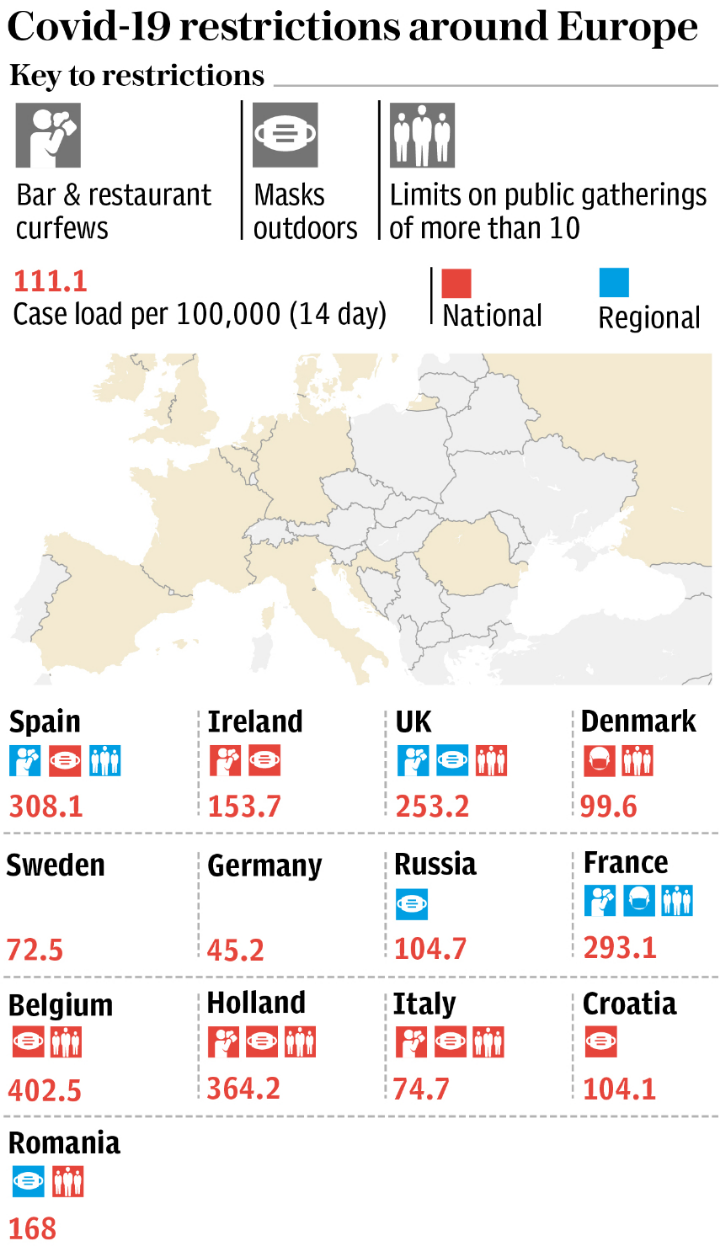
Italy
Italy on Tuesday adopted an array of new measures to combat an alarming increase in the number of coronavirus cases, with around 5,000 being reported each day.
Among the new measures is a ban on all school trips and excursions for children.
Bars and restaurants must now close before midnight and drinking while standing at a bar will be banned after 9pm.
The measure is designed to prevent the large gatherings of young people outside bars and in piazzas, which have been blamed in part for the dramatic rise in infections.
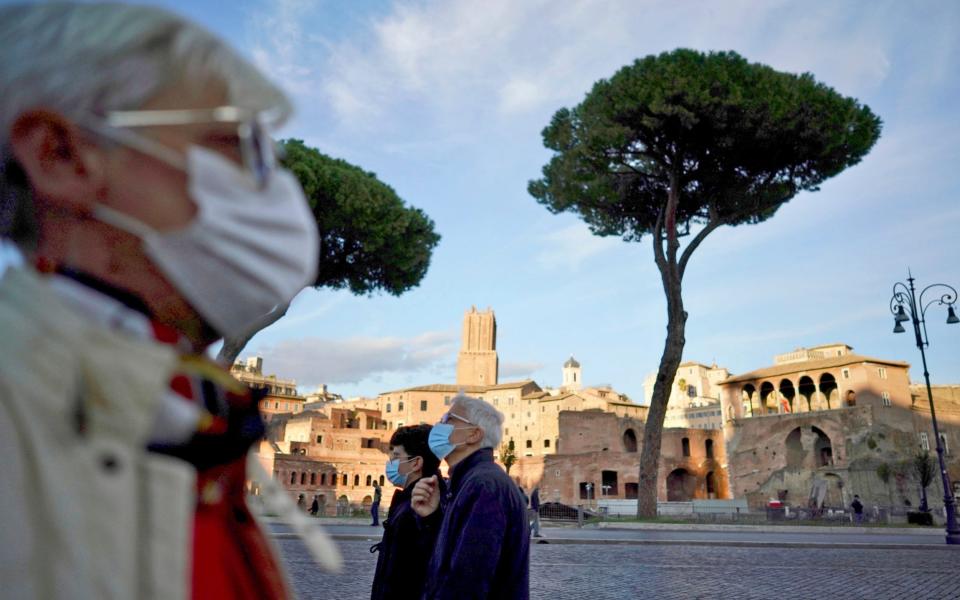
Amateur contact sports such as football and basketball have been banned and Italians were told not to socialise at home in groups of more than six people.
Receptions held after weddings, christenings and first communions must cater for no more than 30 people.
The new decree will be valid for 30 days, the government said.
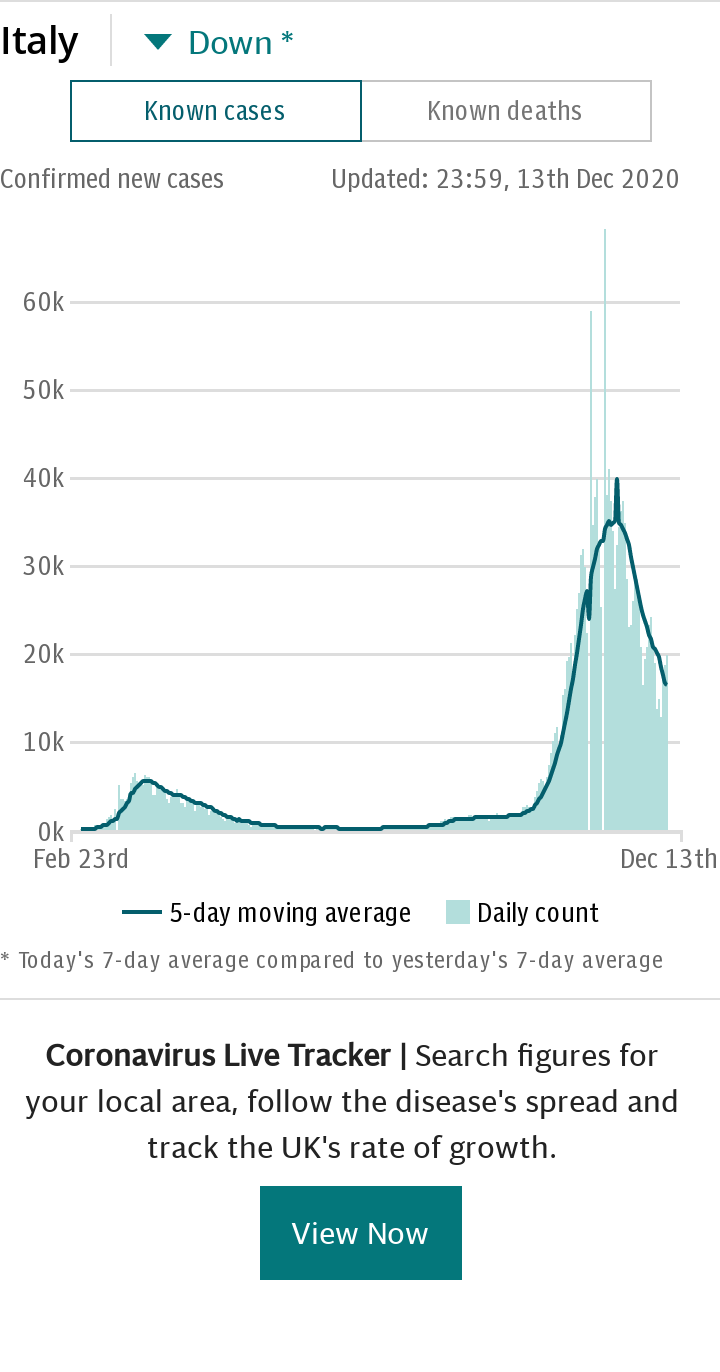
Wearing masks outdoors was made compulsory last week, with the vast majority of people conforming to the new rule.
Italy was the first Western country to be hit by the pandemic and has so far registered around 36,000 deaths.
France
Emmanuel Macron, the French president, held a meeting on Tuesday with his national defence council focusing on the virus. The latest figures showed a rapid increase of infections, especially in big cities.
Currently, nine cities in France, including Paris, Marseille, Lille, Lyon, Montpellier and Toulouse, have been placed on "maximum alert" due to infection rates and the occupancy rate of intensive care beds.
That means that bars and cafes are shut and restaurants can only open if they respect stricter distancing and other sanitary rules. Groups of no more than 10 people are allowed in public.
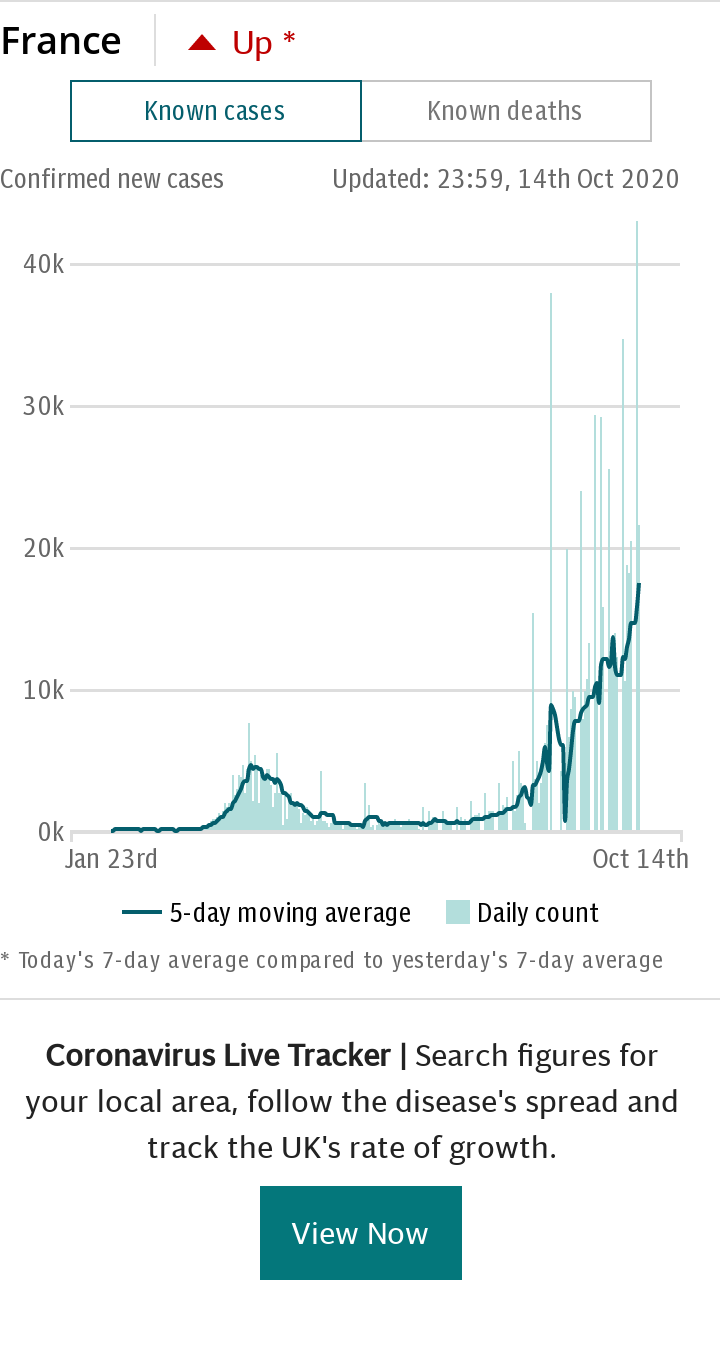
France is in the midst of a "strong second wave" and cannot rule out local lockdowns, Jean Castex, the prime minister, said.
"There can be no let up. The French considered, rather too quickly, that despite what we have been saying the virus had gone," Mr Castex warned on Monday.
More draconian measures may be required, including local lockdowns, he said, while all but ruling out nationwide re-confinement. "Nothing can be ruled out when we see the situation in hospitals."
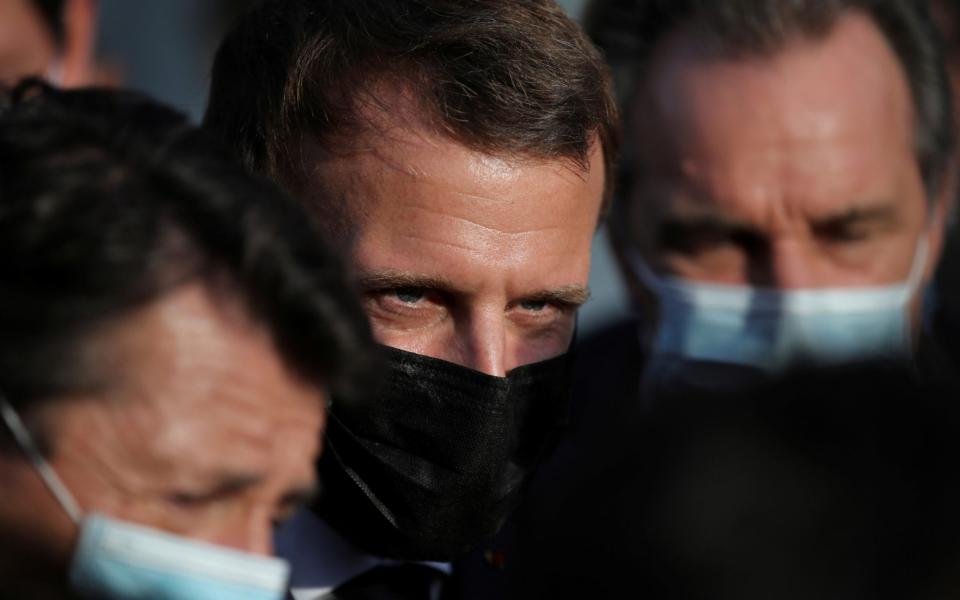
President Emmanuel Macron is due to address the nation on Wednesday evening about the current situation. The number of new infections has been rising and hit a peak last Saturday at more than 27,000 in a day.
On Monday, 96 deaths were reported, bringing the total since the virus first hit the country to 32,825. The situation is particularly worrying in Paris, where the head of the regional health body, Aurélien Rousseau, said that the positivity rate in tests was now 17 per cent - the highest figure ever seen.
The infection rate in the capital now stands at 413 per 100,000 inhabitants, well above the maximum alert level of 250.
The occupancy rate of Covid patients in intensive care has hit 42 per cent. Martin Hirsch, head of Paris hospital group AP-HP, said that within ten days, that figure would reach 70 to 90 per cent. "It's inevitable. The situation is grave," he told Le Parisien.
Spain
As the Covid second wave has kicked in, Spain has become a patchwork of different types of lockdown, involving varying restrictions applied under different epidemiological parameters.
Although the country was under one of the strictest lockdown regimes in Europe due to a national state of emergency that lasted for three months, since June 21 healthcare management has reverted to Spain’s 17 regions.
They are showing vastly different results in terms of containing infections and in how to clamp down on a rising caseload.
Last week, Spain’s national government re-introduced a state of emergency to cover the region of Madrid, where the local authority disagreed with the need to ban non-essential traffic in and out of the capital.

In the city of Madrid and several other suburban towns round the capital, social gatherings are limited to six people, and indoor public spaces must limit capacity to 50 per cent with a closing time of 10pm, or 11pm for bars and restaurants.
But the attempt by Spain’s Left-wing government to impose binding criteria on regions, forcing lockdowns on an area when 14-day transmission reaches 500 new cases per 100,000 inhabitants, has been undermined by a ruling from a Madrid court.
Spain registered just under 28,000 new cases over three days between Friday to Sunday, with 899 deaths in the past week to take the official toll to 33,124 since the pandemic started.
Poland
The Polish government has announced new restrictions to curb the spread of the virus after reporting record infections for a fifth successive day.
The measures included setting aside special shopping hours for senior citizens and increasing funding to care homes.
Poland has reported a total of 135,278 Covid-19 infections and 3,101 deaths since the start of the pandemic in March.
On Tuesday, Polish Prime Minister Mateusz Morawiecki announced he had gone into quarantine after coming into contact with a person who tested positive for Covid-19.
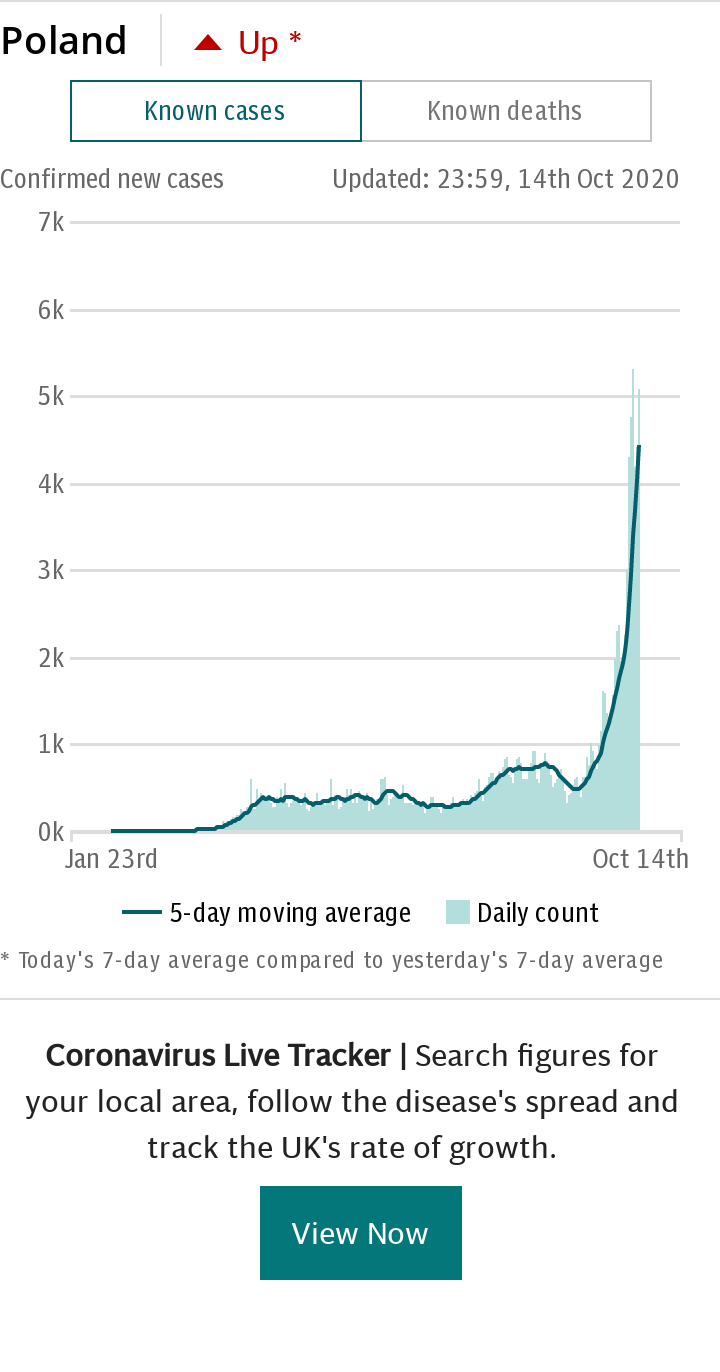
His announcement came as Poland reported 5,068 new coronavirus cases - only the second time the tally has exceeded 5,000 in a 24-hour period since the pandemic began.
During the summer, the new daily cases were around 600, but the numbers started rising quickly after the end of the holidays.
Czech Republic
Pubs and restaurants will close in the Czech Republic on Wednesday and almost all schools will shift to distance learning as the country battles soaring infection rates.
The consumption of alcohol in public has also been prohibited and the government is urging people to stay at home and only travel to work if necessary.
The Czech Republic, which won international praise for its effective response to Covid-19 in the spring, has seen the number of infections rocket upwards in recent days, hitting a record high on Friday of 8,615.
The rapid increase in infections has caused alarm in the country given that on the last day of August only 273 cases were recorded.

With around 493 Covid-19 cases per 100,000 people over the past 14 days, the Czech Republic is now the most affected EU state, and the government has warned that unless the virus can be reined in, the health system could collapse in a fortnight’s time.
“We only have one attempt [at controlling the virus] and that attempt must be successful,” said Andrej Babis, the Czech prime minister.
Announcing the restrictions, which will be reassessed on November 3, Roman Prymula, the health minister, said: “We don’t have a year, we don’t have a month. The measures must take effect in the next 14 days. No one expected the rates to accelerate as much as they did last week.”
Czech medical students in their final year of studies could also be called up to help ease the burden on the country’s creaking health service.
Germany
Germany is currently in the grip of a political row over restrictions on internal travel. With weekly infection rates rising rapidly, regional governments agreed last week on a ban on hotel or holiday rental stays for anyone from an area where the rate is above the German high-risk threshold of 50 per 100,000.
But the decision, just ahead of half-term, has caused uproar. Many families say they only booked holidays in Germany because they were advised to by the government, but now face cancelled trips and lost money.
The new rules, which currently affect people from cities including Berlin, Munich, Cologne and Frankfurt, have also come under fire from the German hotel and restaurant industry, which says they could leave many businesses facing bankruptcy.
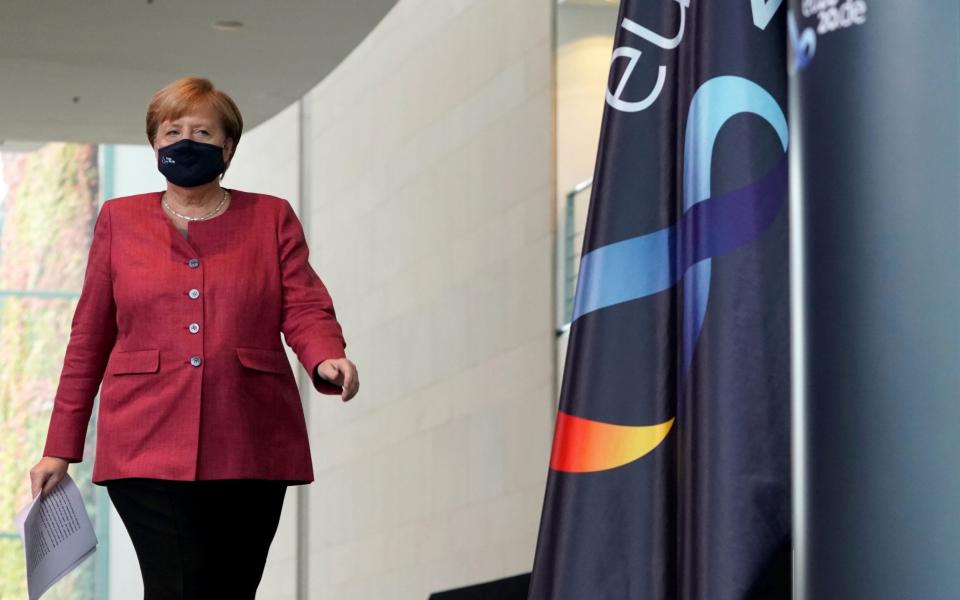
Several German regions, including Berlin, are refusing to enforce the ban and there are calls for a U-turn ahead of talks between Angela Merkel and regional leaders on Wednesday.
Other restrictions vary widely around the country. Berlin, which until recently had one of the most liberal coronavirus regimes, recently introduced an 11pm curfew for pubs and restaurants.
For the first time since the end of the Second World War, all shops have been ordered to close in the German capital between 11pm and 6am — including the city’s famous Späti late-night stores.
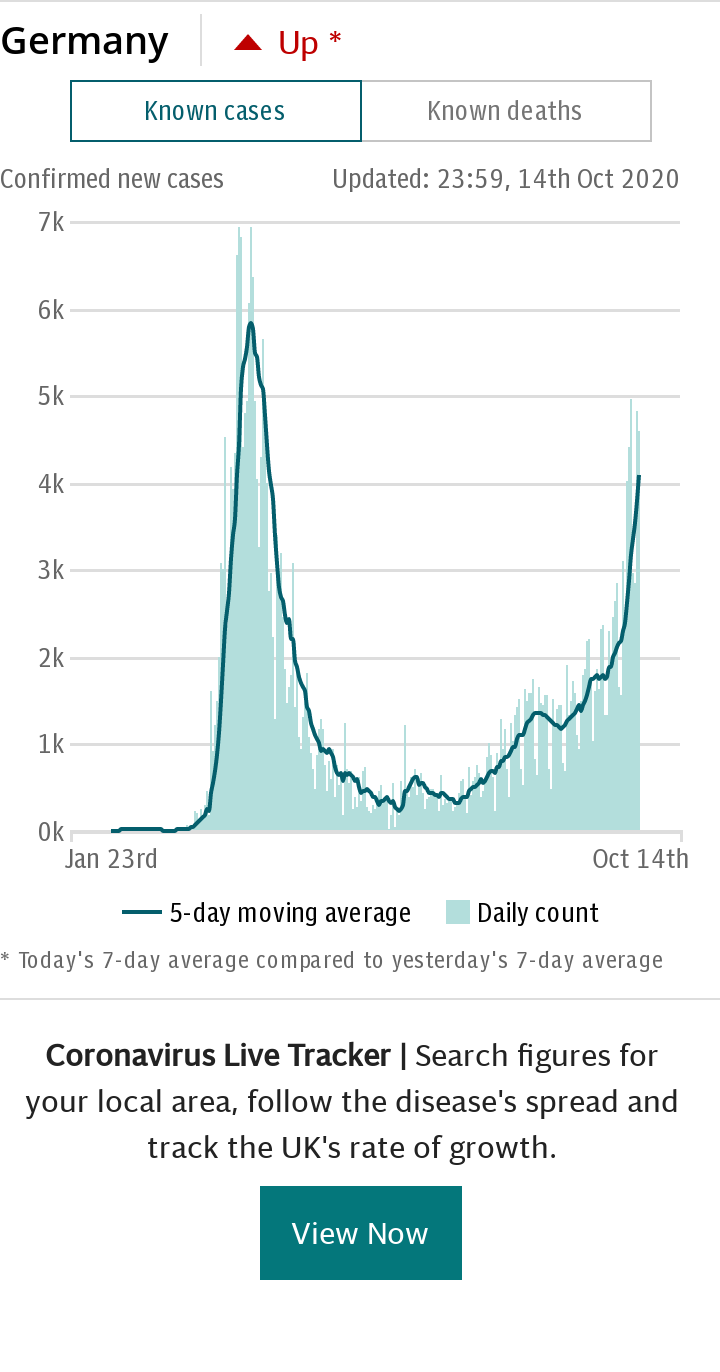
Only pharmacies and petrol stations are exempt. Berlin has also introduced a “rule of five” for private gatherings, but only at night. By day, gatherings of up to 10 people are still allowed.
Restrictions around much of the rest of Germany remain loose compared to most European countries. In many regions up to 50 people are still allowed at private gatherings, and even in high-risk areas the limit is 25.
German children have been told to take blankets to school with them after schools were ordered to open windows every 20 minutes to ventilate classrooms. Opening the windows a little is not deemed satisfactory. Under new regulations, they must be opened fully for three to five minutes.
Sweden
Sweden's public health agency on Tuesday announced that from October 19th, it would work with regional infectious disease departments to consider temporary measures for regions suffering high levels of infection.
Although the measures will be recommendations rather than bans, Sweden's state epidemiologist said he was confident they would be followed.
"We have very good experience of this so far, and we know from various studies that people in Sweden have made extremely big changes to their behaviour and continue to do so," he said. "I think we have good reason to believe this will work fairly well."

The temporary recommendations might include a call for people to avoid travelling on public transport, to avoid all unnecessary travel, to cease all visits to people in risk groups or to elderly care homes, to stop visits to restaurants, gyms, or other indoor environments, and even to avoid all contact with anyone they do not live with.
While Sweden avoided the rise in infection rates seen elsewhere in Europe at the end of August, in September the number of new daily cases has risen steadily from a seven-day rolling average of less than 17 new cases per million on September 3rd to more than 56 cases on October 9th.
The health authorities nonetheless lifted a ban on visiting elderly care homes on October 1st, with Dr Tegnell arguing that the negative consequences of depriving elderly people of social contact had become too great.
Denmark
Denmark last week extended emergency coronavirus restrictions put in place in mid-September until the end of this month, with health minister Magnus Heunicke explaining that while the infection rate was “going in the right direction", it remained too high.
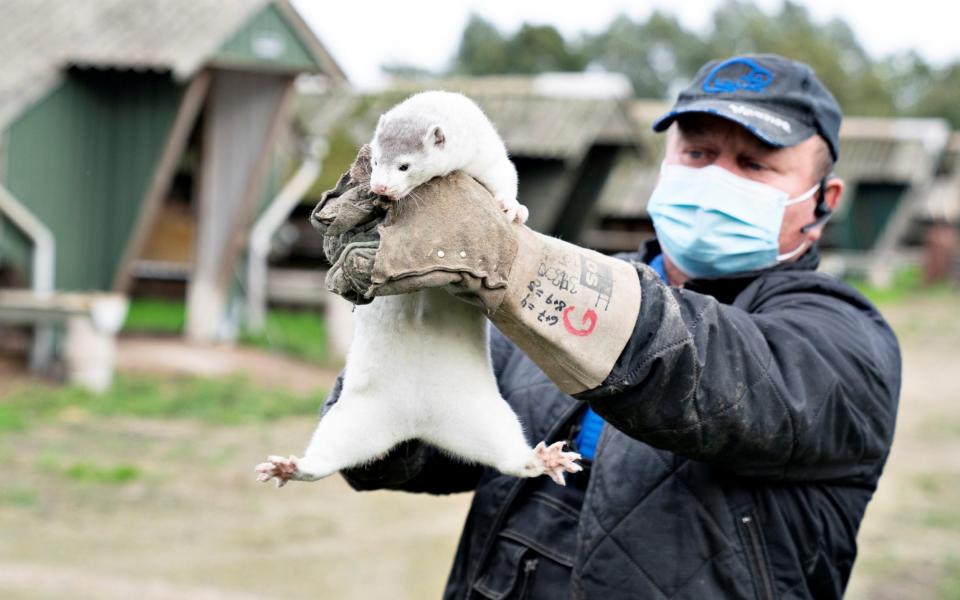
That means face masks must be worn at all times on public transport and when standing in cafes and restaurants. Cafes and bars must close at 10pm and there must be no gatherings of more than 50 people. The Danish health authority at the end of September added hospitals, care homes and GPs' surgeries to the list of places where face masks are mandatory.
The number of new cases per day in Denmark has stabilised at below 400, after as many as 1,500 new cases were recorded on the worst day at the end of last month. Despite the series of outbreaks, the death rate has stayed below five a day.
Norway
Norway on Monday relaxed its restrictions on some adult amateur sports, allowing training with close contact to be resumed, and also lifted the national ban on bars staying open past midnight. It also allowed outdoor events for as many as 600 people, as long as they are divided into groups of 200.
After seeing a rise in cases between the middle of July and the end of September, Norway's infection rate has stabilised.
However, with Oslo still seeing by far the highest numbest of new cases in the country, the city authorities are keeping a midnight closing time in place. Oslo's government also recommends that no more than ten people meet together for private gatherings, twice the 20 person limit imposed in other regions.
Netherlands
The Netherlands ordered cafes and restaurants to close yesterday and banned evening alcohol sales, as it entered “partial lockdown” to curb rising coronavirus infections.
Authorities on Tuesday announced there had been 7,393 infections in 24 hours, which is a new record.
On Tuesday, a Dutch woman with underlying conditions died after catching coronavirus for a second time. Groups of people will be limited to four, both inside and outside.
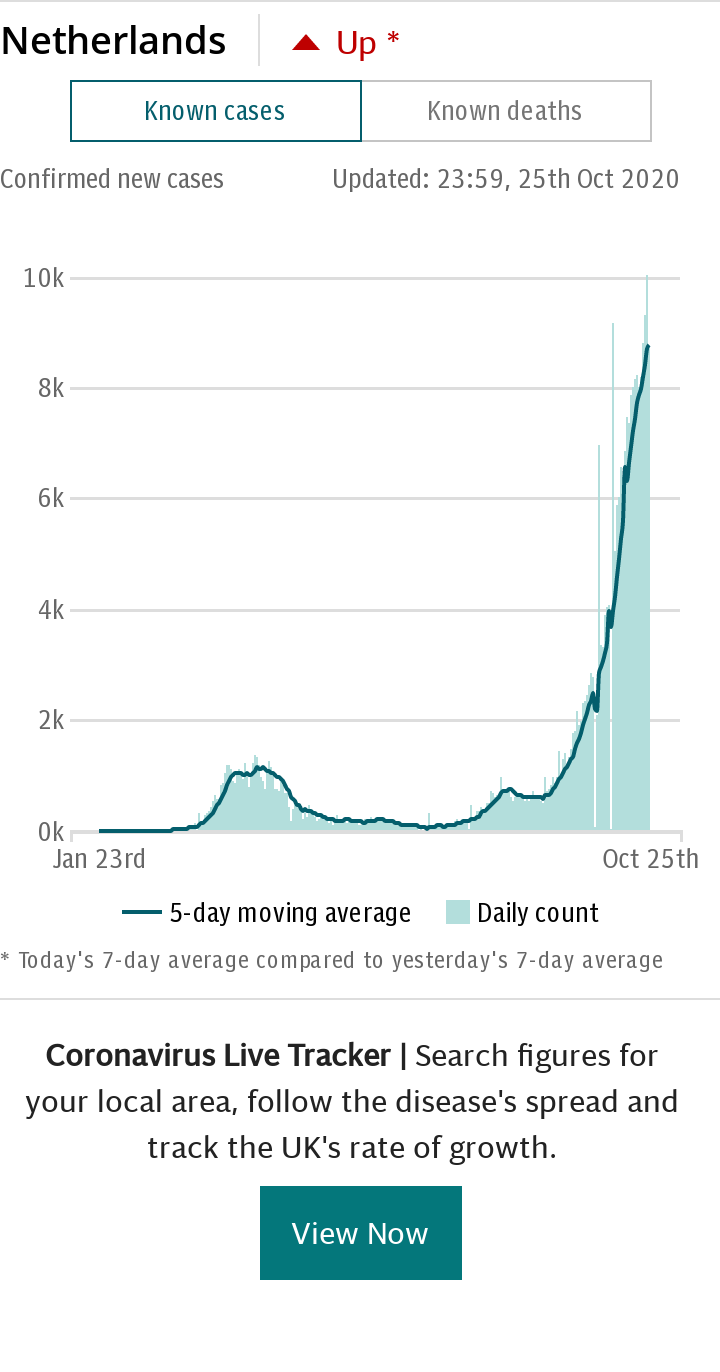
A maximum of three visitors per day will be allowed per household.
"We are going to a partial lockdown", Mark Rutte, the prime minister, said, "That hurts, but it's the only way." Mr Rutte said too many people had not complied with previous, more lax rules.
Belgium
There are rising concerns that another lockdown in Belgium is inevitable after it was announced on Tuesday that coronavirus infections, deaths and hospitalisations had all risen sharply.
There was an average of almost 4,500 people a day testing positive over the last week, according to the latest figures, an increase of 79 percent on the previous week.
There were an average of 17 deaths a day, an increase from 13.6 in the week before October 6 to 12.
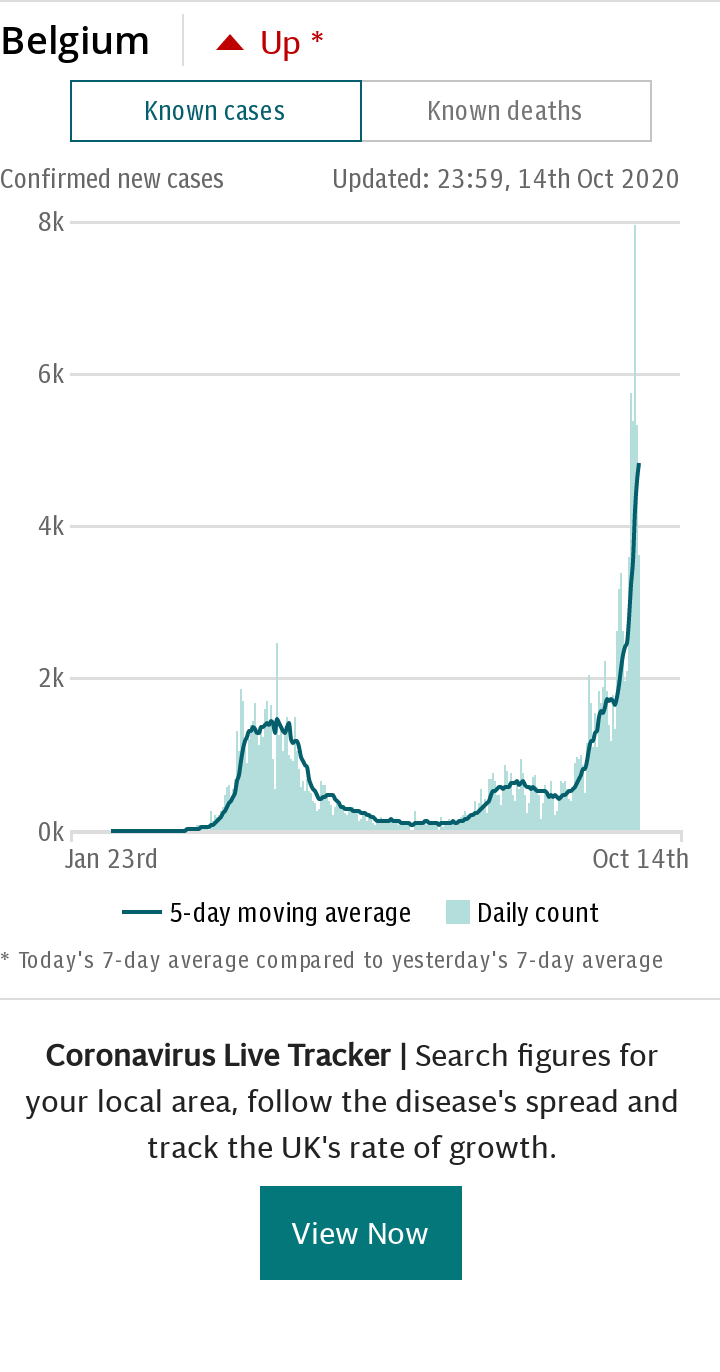
On average, 136 people were hospitalised each day over the same period.
Belgium’s R number is 1.4, which means that one infected person infects more than one other and that the epidemic is growing, despite tighter restrictions introduced last week.

Belgium introduced a nationwide “rule of four”, shrinking social bubbles from five for a month, and early 11pm closing times for bars, restaurants and cafes.
Meetings outside are limited to four people, gatherings at home are limited to four visitors, and customers in cafes are limited to four per table, unless they all live together.
Brussels, the country’s infection hotspot, closed all cafes and bars for a month. Drinking in public is banned but restaurants can stay open.
On Tuesday, the provinces of Wallon Brabant and Luxembourg introduced a 1am to 6am curfew for 15 days and banned Halloween door-to-door trick or treating.
Campaigners called for prisoners to be released because overcrowding was an infection risk.

 Yahoo News
Yahoo News 
